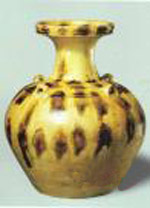| Legole.Com Discover china. Explore the beauty and wonder of the land, people, and culture of China. |
 |
|
|
 |
| |
 After the collapse of the Western Jin Dynasty (265 - 316), the Han government retreated to the east of the Yangtze River. In 317, Sima Rui, a member of the Jin royal family stationed in Jiankang (present city of Nanjing in Jiangsu Province), re-established Jin supremacy, through what has become known as the Eastern Jin Dynasty (317 - 420).The Eastern Jin Dynasty had lasted for 103 years with eleven emperors over fourteen generations until it was substituted by the Song Dynasty founded in 420. After the collapse of the Western Jin Dynasty (265 - 316), the Han government retreated to the east of the Yangtze River. In 317, Sima Rui, a member of the Jin royal family stationed in Jiankang (present city of Nanjing in Jiangsu Province), re-established Jin supremacy, through what has become known as the Eastern Jin Dynasty (317 - 420).The Eastern Jin Dynasty had lasted for 103 years with eleven emperors over fourteen generations until it was substituted by the Song Dynasty founded in 420.
In the Eastern Jin period, the development of powerful family politics reached its peak as royal power was on the decline. Some noble families, by right of their contribution to the foundation and consolidation of the Jin, then led a life of luxury and privilege. Born from different regional and cultural backgrounds, they struggled and supplanted each other. During the over one-hundred-year reign of the Eastern Jin, noble families from the Central Plains were in a dominant situation and Wang, Xie, Yu and Huan families even determined state affairs.
Actually, the eastern Jin only controlled the area south of the Yangtze River, leaving the North China occupied by other ethnic groups. During the period from the beginning of the fourth century to the first part of the fifth century, many ethnic groups founded their own states in this area. Historically, fifteen major states in the north, together with the Kingdom of Chenghan in the southwest area, were called "the Sixteen States".
The sixteen states never stopped fighting against each other, with wars and conflicts destroying the economy in the northern areas. The mix of nationalities was accelerated through the long term contacts and mutual influences.
Situated in the south area of the Yangtze River, Jin emperors never gave up the efforts to reoccupy the North China. Zudi, a southern gentry-official, once led a northern expedition and regained the Yellow River Valley for a short time. Afterwards, noble families in power repeatedly advocated northern expeditions to enhance their prestige. They once took Luoyang, entered the Central Shaanxi Plain and approached Hebei. However, these triumphs were all short-lived because of the counterattack by the ethnic groups.
In the late part of the fourth century, Qianqin (Former Qin) was set up by the Di ethnic group and reunified the Yellow River Valley. The Emperor Fujian endeavored to develop the economy and made his state stronger.
In 383 AD, despite the objection from all social groups, Fujian drafted soldiers from all nationalities to launch a war against the Eastern Jin. Xie'an, the Prime Minister of the Eastern Jin, offered resistance and sent Xieshi and Xiexuan to fight against this attack. Finally the Eastern Jin won in a decisive battle along Feishui River, putting an end to the war. After the battle of Feishui River, Qianqin State collapsed quickly and the Eastern Jin had the chance to reoccupy many areas..
However, the expelling of the external threat was followed by a series of internal disturbances. First, Sun'en and Luxun launched rebellions. Then Huanxuan won the civil war and usurped the throne. Later, General Liuyu of the Beifu troops suppressed the peasant uprisings and, relying on his prestige gained through northern expeditions, established his own state to replace the Eastern Jin. The Eastern Jin Dynasty was gone however the disunion continued. China now entered another divisive age of the Northern and Southern Dynasties.
Economy
During the Eastern Jin Dynasty, the noble families devoted themselves to the economic development. Due to the incessant wars in North China, peasants gradually migrated into the area south of the Yangtze River in pursuit of a more peaceful life. The migration not only reinforced the manpower in these areas, but brought advanced productive implements and techniques. In addition, the many rivers in the area south of the Yangtze River, provided good irrigation conditions for the agricultural production. All these factors contributed to the development of agriculture in this area.
Also, people from the north brought improvements to handicraft industry. Commerce progressed in this period. Jiankang, the capital city of the Eastern Jin became the largest businesses city in the area south of the Yangtze River. The economic center began to move to the Yangtze River Valley from the Yellow River Valley.
Eastern Jin Dynasty -- Five Hus and Sixteen States
From the end of the Western Jin (215 - 316) to the Northern Wei, five ethnic groups once founded their states in the North China. They were called by a joint name "Five Hus and Sixteen States".
The Five Hus: were the five ethnic groups that live in north china, namely Xiongnu, Xianbei, Qiang, Jie and Di.
The Sixteen States: include Qianliang (Former Liang), Houliang (Latter Liang), Nanliang (Southern Liang), Xiliang (Western Liang), Beiliang (Northern Liang), Qianzhao (Former Zhao), Houzhao (Latter Zhao), Qianqin (Former Qin), Houqin (Latter Qin), Xiqin (Western Qin), Qianyan (Former Yan), Houyan (Latter Yan), Nanyan (Southern Yan), Beiyan (Northern Yan), Xia and Chenghan.
|
|
|
 |
|
